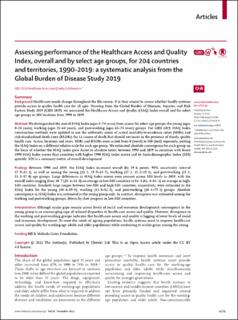| dc.description.abstract | Background
Health-care needs change throughout the life course. It is thus crucial to assess whether health systems provide access to quality health care for all ages. Drawing from the Global Burden of Diseases, Injuries, and Risk Factors Study 2019 (GBD 2019), we measured the Healthcare Access and Quality (HAQ) Index overall and for select age groups in 204 locations from 1990 to 2019.
Methods
We distinguished the overall HAQ Index (ages 0–74 years) from scores for select age groups: the young (ages 0–14 years), working (ages 15–64 years), and post-working (ages 65–74 years) groups. For GBD 2019, HAQ Index construction methods were updated to use the arithmetic mean of scaled mortality-to-incidence ratios (MIRs) and risk-standardised death rates (RSDRs) for 32 causes of death that should not occur in the presence of timely, quality health care. Across locations and years, MIRs and RSDRs were scaled from 0 (worst) to 100 (best) separately, putting the HAQ Index on a different relative scale for each age group. We estimated absolute convergence for each group on the basis of whether the HAQ Index grew faster in absolute terms between 1990 and 2019 in countries with lower 1990 HAQ Index scores than countries with higher 1990 HAQ Index scores and by Socio-demographic Index (SDI) quintile. SDI is a summary metric of overall development.
Findings
Between 1990 and 2019, the HAQ Index increased overall (by 19·6 points, 95% uncertainty interval 17·9–21·3), as well as among the young (22·5, 19·9–24·7), working (17·2, 15·2–19·1), and post-working (15·1, 13·2–17·0) age groups. Large differences in HAQ Index scores were present across SDI levels in 2019, with the overall index ranging from 30·7 (28·6–33·0) on average in low-SDI countries to 83·4 (82·4–84·3) on average in highSDI countries. Similarly large ranges between low-SDI and high-SDI countries, respectively, were estimated in the HAQ Index for the young (40·4–89·0), working (33·8–82·8), and post-working (30·4–79·1) groups. Absolute convergence in HAQ Index was estimated in the young group only. In contrast, divergence was estimated among the working and post-working groups, driven by slow progress in low-SDI countries.
Interpretation
Although major gaps remain across levels of social and economic development, convergence in the young group is an encouraging sign of reduced disparities in health-care access and quality. However, divergence in the working and post-working groups indicates that health-care access and quality is lagging at lower levels of social and economic development. To meet the needs of ageing populations, health systems need to improve health-care access and quality for working-age adults and older populations while continuing to realise gains among the young. | en_US |

